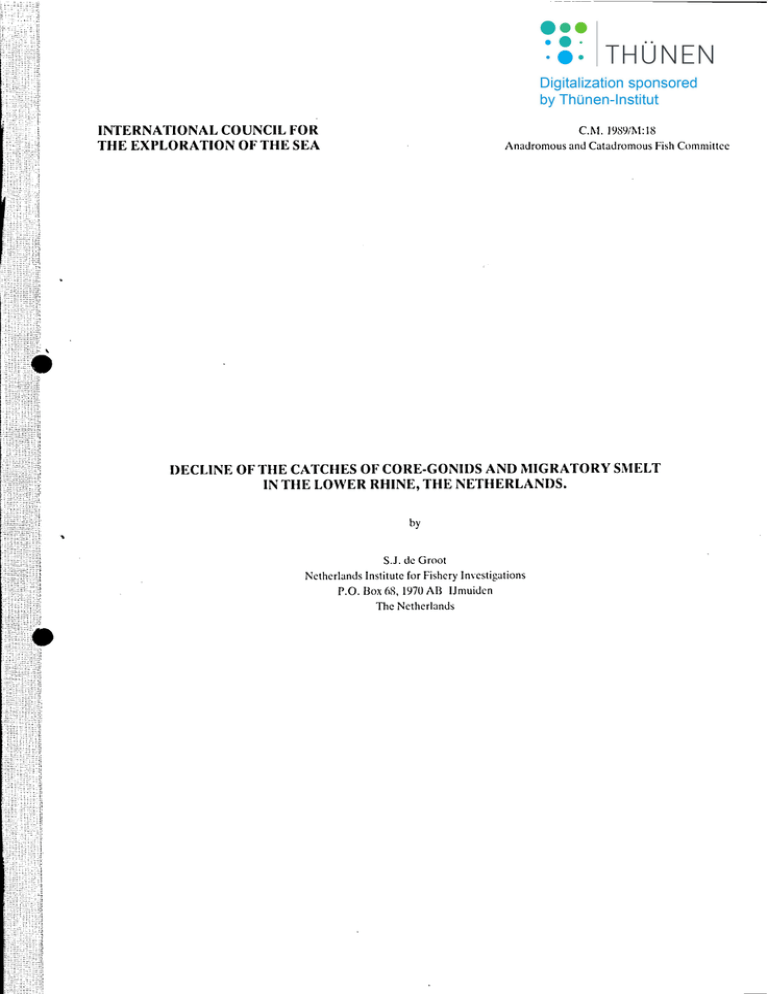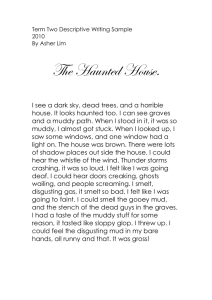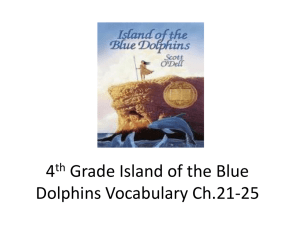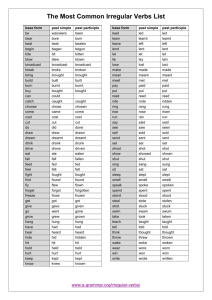INTERNATIONAL COUNCIL FOR THE EXPLORATION 01' THE SEA
advertisement

INTERNATIONAL COUNCIL FOR THE EXPLORATION 01' THE SEA C.M. 191)9/M:18 Anadromous and Catadromous Fish Committee DECLINE 01' THE CATCHES 01' CORE-GONIDS AND MIGRATORY SMELT IN THE LOWER RHINE, THE NETHERLANDS. by 5.1. de Groot Netherlands Institute for Fishery In\'estigations P.O. Box 68, 1970 AB IJmuiden Thc Netherlands INTERNATIONAL COUNCIL FOR TUE EXPLORATION OF TUE SEA CM 1989/M:18 Anadromous and Catadromous Fish Committee • DECLINE OF TUE CATCHES OF COREGONIDS AND MIGRATORY SMELT IN THE LOWER RHINE. by Dr. S.l. de Groot Netheriands Institute for Fishery Investigations P.O. Box 68, 1970 AB Umuiden The Netheriands Contents Abstract.•.•.....•....•.........•.•....•..•.•........•......•.•........•..•. 2 Int::rOOuction 3 Coregonids 3 Smelt 3 Fteferences ....••.•..•..........................•...••••..••......•••..•... ~ Abstract Cateh data of eoregonids (Coregonus albula, C. lavaretus), notwithstanding the speeies were abundant for many hundred years, dates only from 1910. In 1918 the eommercial fishery eame to an end. The highest reeorded eateh 1~,6 tons was in 1915. Extensive restocking operations between 1907 -1938 were all failures. At present still a few specimens are yearly eaught, from releases, re-stoeking programmes - in West Germany (FFtG) Migratory (anadromous) smelt (Osmerus eperlanus) was onee an important fishery in the Zuiderzee and Fthine-Seheldt estuary. The fishery in the Zuiderzee eame to an end in 1932 when the enclosure dam was eompleted. The smeltfishery in the lower reaehes of the Fthine came to an end in 1966 when the "Delta-works" were eompleted in Hollands Diep and Haringvliet. -2- • Introduetion In the framework of the International "Ecologicat Rehabilitatiori of th6 Rhine"programme, an initiative shared. by Frarice, German Federal Republic and the NetherlandS, a desk sttidy was undertaken to evaluate existing information on the decline of the coregonid fisheries and the smelt (Osmerus eperlanus (L.» iri the river Rhine. Also to indicate causes for the decline. CoregonidS were commercially caught in the whole section of the Rhine flowing through the Nethedands, smelt (migratory forin) only the lower reaches arid estuary. Corcgonids Dependlllg what systematic division one Ükes to follow, two or tllree corcgollid species inhabit(ed) the Rhine., Coregomis lavarctus lavaretus (L.) (white fish); C. oxyrinchus (L.) (Houting); C. albula (L.) (Vendace). It is beuer to see ,Co oxyrinchus (L.) a subspecies of the white fish hence, C. lavaretus oxyrinchus L. (Redeke, 1934, 1941; Nijssenand de Groot, 1 9 8 7 ) . , . , .. The vendace has only been caught a few,times (last 1927) but if it occurs is likely not recognized. The fisheries concentrated on whitefish/houting. Only migrating forms of the coregonids enter our waters, spawning has never been established in the past. At the turn of the last century whitefish was caught in alllarge rivers Rhine, Ussel, Meuse. . The fisheries concentrated in the months August-November. Catch data are difficult to trace before 1910 as the fish was sold directly by the fishennen themselves. It was possible to obtain data from 1910-1939. Table 1, figurc 1, show the" data Remarkable, is the strong decline from 1916-1920. In 1917 catches were still about 5000 kg:' . In 1921 1000 kg, in 1927500 kg, in 1933 100 kg and in 19393 kg. The decline is far quicker than those observed in the salmon catches(de Groot; 1989 a). For the govemment the downfall, and nearly extinction of the species was reason for concern. Artificial rearing was tried (1907 first time) and restocking with eggs; I-month or 1 year old whitefish (everi from Russia, Peipus-Lake). In total nearly 119 million larval 01juvenile whitefish were released between 1907 -1939 in our inland waters. This all without any noticeable result. as •, a At present there is in Germany(GFR) growing concern io preserve coregonids. The non-inigratory forms in the German alpirie lakes are threatenoo by pollution. Hence large restOcking operations are yearly camed out also in large lakes formoo by barrages (Talsperre); coregonids are released in Nordrhein-\Vestfalen arid Hessen. Tbe present day increase of caught individuals in Rhine and Ussellake must originate from all these attempts. And there is no serious recovery of the coregonids in our waters. As migratory forms of coregonidS reach the estuaries, the brackish zone and coastalwaters only in the extreme, there will b6 no serious negative effects of the large construction worles in the Rhirie-Scheldt estuary (Delta works). Pollution in the spawning areas must be seen as the major cause for the decline of coregonids. Release in rhe inland waters of coregonids is not a good proposition as is clearly demonstrated between 1907 -1939. SrilCIt Smelt is represented in the Dutch waterS in its migratory (anadromous) as weIl as land locked (non-migratory) form. The migratoryfornl is known from the estuaries ; Wadderi Sea and lower reaches of the largo rivers, the non-migratOIY form at present is found in large quantities in the Ussellake (at present 4000-5000 ton/yr), the Frisiall Lakes arid in the provinces North and South Holland. -3- Table 2 shows the catches and eamings for 1980-1988 of Ussellake smeIt, Table 3 shows the catches of migratory smelt 1914-1919 for the Hollands Diep, HaringvIiet area and figure 2 gives the catches for the same area form 1946 -1986. It can be seenthat since 1966 no migratory smelt has been caught int he lower reaches, the freshwater and bnickish tidal area of the Rhine. In 1970 the lrirge construction works of the Delta works were completed and the area virtually closed off from the sea (only open 2.6% of the year). That not all migratory smelt vanished from our coastal waters is shown in figure 3 showing the catches from 1946-1988. The riligratory smelt obtains a length of up to 30 cm in its eight year (Mohr 1941). The non-migratory smelt in the freshwater lakes and large rivers has a length of 8-15 cm. But the non-migratory smelt ofthe Ussellake, a very large freshwater body, will even reach iri its fourth year a length of 19 cm (first - 6 cm, second 12 cm, third 14 cm). The large nonmigratory smelt is, however, not common. (Redeke 1907, 1914, 1922 and Havinga 1928, 1954). Redeke (1914) indicated that migratory smelt spawned in the lower reaches of the Rhine, in the freshwater tidal area of the Hollands Diep, between Moerdijk-bridges and Willemstad. In the upper reaches of the Rhine in the Netherlands, near Arnhem and Nijmegen the migratory smelt always was a rare fish (Van den Ende 1847). The non-migratory smelt spawns in lakes and rivers. In both cases spawning takes place from February - April when temperatures are between 4-12 °C. Eggs are laid and stuck to stones, gravel, waterplants, but never on silt bottoms. The eggs are ellipsoid and on average a female carries 40.000 eggs. The average egg density is 6 eggs/cm2, but sometimes eggs are found in layers. The larvae appears between 140-162 day degrees (20 -18°C). The reason for the decline of the Rhine smelt is linked to the migratory and spawning habits. The lower reaches of the Rhine have stopped to be tidal and are unreachable for the migratory fish. The siltation of the river-bed has increased since the cIosure. In 1987 it has been estimated tlmt about 70 million cubic meters of silt have been depösited in the lower reaches of the Rhine of which 50 million cubic meters have been deposited in Hollands Diep and Haringvliet. In the part of the river still directly open to the sea, the part flowing through Rotterdam about 5 million cubic meters of silt have been deposited. Also the silt content ofthe Scheldt-estuary increased (Anon., 1987). The silt covered, arid heavily polluted bottom is unsuited for the survival of the eggs. H.cfcrcllccs Anon., 1987. Vervuilde baggerspecie is groot aandachtsgebied van overheid. Land en \Vater, 27 (3): 60-61. Ende, \V.P. van den, 1847. Eenige bijzonderheden betreffende den spiering op den IJssel. Versl. werzh. Ver. tot bevord. Inl. Ichtlyol, 1: 51-55, 6976. de Groot, S.l., 1989. Data on the Dutch fisheries on salmon (1863-1957) and trout (1886-1986) fisheries in the river Rhine. International Council Exploration Sea C.M. 1989. Ana Cat. Fish Comm., M. Havinga, B. 1928. De spiering iri de Zuiderzee. Meded. van de Zuiderzee Commissie 1 : 18 pp. Haviriga B., 1954. Vissen. In: Veranderingen in de Flora en Fauna van de Zuiderzee (thans IJsselmecr) na afsIuiting in 1932. L.F. de lleaufort (edit.) Neth. Zool. Soc. Den Helder, pp. 253-267. -4- • \ Mohr, E., 1941. Stint (Osmerus Artedi) in R. Demoll and Maier. Handbuch der Binnenfisherei Miueleuropas, Bd III (7a), I-lI, 5040-526. Nijssen, H. and S.l. de Groot, 1987. De vissen van Nederland Nath. BibI. KNNV 43. Hoogwoud KNNV, pp 223. Redeke, H.C., 1907. De spiering (Osmerus eperlanus). In: Rapport over onderzoekingen betreffende de visscherij in de Zuiderzee ingesteld in de jaren 1905 en 1906 H.C. Redeke, Min. Landbouw, Nijverheid en Handel, 's-Gravenhage, p.p. 40, 41, 79-81. Redeke, H.C., 1914. De spiering en de spieringvisscherij. Meded. Vissch. 21: 51-54; 70-74; 83-85. Redeke, H.C., 1922. Visschen. In: Flora en Fauna der Zuiderzee. H.C. Redeke et al. edit. Neth. Zool. Soc., Den Helder, p.p. 426-442. • Redeke, H.C. 1934. Über den Rheinschnäpel, Coregonus oxyrhynchus L. Verhandl. d. Interna! Vereinig. für Limnologie. 6: 352-357. Redeke H.C., 1941. Pisces (Cyclostomi - Euichthyes). In : Fauna van Nederland, Sijthof, Leiden, vollO: 1-331. -5- Tabel 1: Dutch coregonid catches 1910-1939. Year Landings (kg) 1910 1911 1912 1913 1914 1915 1916 1917 1918 1919 1920 1921 1922 1923 1924 1925 1926 1927 1928 1929 1930 1931 1932' 1933 1934 1935 1936 1937 1938 1939 2.769 kg 3.586 kg 1.665 kg* 1.241 kg* 3.170 kg* 14.682 kg* 3.298 kg 4.737 kg 1.175 kg 1.644 kg 720kg 972kg 130kg 25kg 690kg 65 kg 597 kg 534kg 115 kg 140kg 24kg 109 kg 139kg 129 kg 53 kg 1 kg 2kg 46kg Okg 3 kg *= underestimate - 6- • ,.; Table 2: Ussellake smelt catches 1980-1988. Landings (kg) 1980 1981 1982 1983 1984 1985 1986 1987 1988* • Table 3: 157000 160 ()()() 2309000 1235000 1305000 1357000 1881000 2317 000 3319000 Smelt catches in Hollands Diep and Haringvliet 1914-1919. Year Total ~g) 1914 1915 1916 1917 1918 1919 140771 109366 225955 101097 176055 146275 -7- • 16000 • 14000 12000 10000 Kg. 8000 6000 4000 2000 • /\ . • 1· . . . ../ . . •, • /\ .... .-., ., .-. I I I I I I I I I I f ~-.~.""l l-~-~-.-~-~-~-.-.-.-._._. 1910 1912 1914 1916 1918 1920 1922 1924 1926 1928 1930 1932 1934 1936 1938 o Year Fig. 1. Dutch coregonid catches 1910 - 1939. r I 350000 T 300000 • • 250000 ·kg 200000 150000 100000 50000 • /\ • • . IV.V·· 1·\ ..... .' " ••\ • • I' o 1946 1951 1956 1961 •" ~ ••• ~ •••••••••••••••• 1966 1971 1976 1981 1986 Year Fig. 2. Smelt catches in Hollands Diep and Haringvliet 1946 - 1988. 1 300000 • •• 200000 kg • 150000 • 100000 M e~ ~ /\ e 50000°. o , 250000 ee,e,e. oe • je.e\. , '\ '\. 0·.. e ~e e. ,e, , 'e .• I I I I I 1'1 e·~~~~+~I 1946 1951 1956 1961 eI i , A •• \ • I I I I I I I , I I ( I ••••• 1966 1971 1976 1981 1986 Year Fig. 3. Smelt catches in the D~tch Waddensea 1946 - 1988. r ,• \ •• ,, • I I I ( I • NORTH SEA .... ---' ,. • " I , Hoek ,. Ttl.n FRG , .... , 1..- - ......... - ,--,,., I I DELGIUM ... ,. , \ .... -~-- 1l.=lIaringvliet; 1l.=Biesbosch Rott.=P.otterdam; S.=Sluices IJm.



